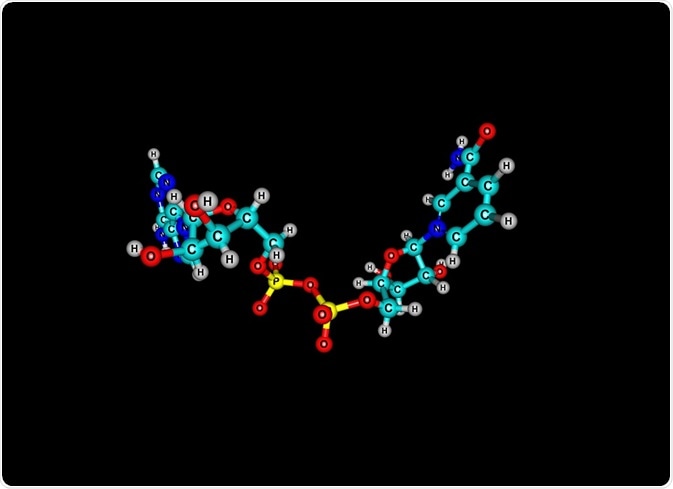Nicotinamide adenine dinucleotide (abbreviated as NAD) is a fundamental component of various redox reactions. NAD is the coenzyme form of niacin (vitamin B3) and is known to play a role in DNA repair, signal transduction and post-translational modifications.
 Image Credit: Igor Petrushenko / Shutterstock.com
Image Credit: Igor Petrushenko / Shutterstock.com
Enzymes involved in de novo biosynthesis and salvage pathways, as well as in down-stream utilization of NAD, have been studied thoroughly, and, as a result, implicated in a panoply of diseases.
From these studies, NAD-based therapeutics have emerged as a potential new avenue for treating a wide array of medical conditions - from physiological aging process to malignancies.
The protean roles of NAD
NAD can be considered a two-faced compound present in all kingdoms of life. It is not only a cofactor in redox reactions and metabolic pathways, but also a substrate needed by enzymes for post-translational modification.
NAD is particularly involved in deacetylation and adenosine diphosphate (ADP) ribosylation reactions, producing mono-ADP and poly-ADP ribose moieties bound to nucleic acids and proteins.
Therefore, it can be said that NAD is an obligatory oxidizing co-substrate for various enzymes. It is subsequently reduced to NADH that carries electrons all the way to the electron transport chain for oxidative phorphorylation and the production of adenosine triphosphate (ATP).
In addition, NAD is capable of transferring ADP-ribose moieties to specific proteins, which results in nicotinamide production.
During deacetylation, sirtuins (belonging to the histone deacetylase family) utilize NAD to remove acetyl groups from proteins.Lysine deacetylation is coupled to NAD hydrolysis in the deacetylation reaction, which yields nicotinamide and O-acetyl-ADP-ribose.
A certain number of sirtuins also behave as ADP-ribose-modifying enzymes in specific compartments. NAD also acts as a precursor of the second messengers: NAADP (nicotinic acid adenine dinucleotide phosphate) and cyclic ADP-ribose.
NAD is primarily consumed in ADP-ribose transfer reactions, and used to generate oligoadenylates and diadenosine tetraphosphate.
Finally, membrane receptors in plants recognize extracellular NAD, and its increased availability increases the immune responses towards plant pathogens.
NAD in mammals
More recently, the biochemistry of NAD has been broadly studied in mammals with respect to its biological functions and processes. NAD plays a substantial role in hepatosteatosis, circadian clock modulation, and various other age-related metabolic issues.
Albeit a significant body of work elucidating the role of NAD in various organs has been carried out, the intestines are not so well studied, and the effect of aging on colon function is not completely understood. The notion that NAD can function as an inhibitory and purinergic neurotransmitter is quite controversial.
Nevertheless, a purported association between NAD level and age-related changes in intestinal motility has been established. Thus, it remains to be seen whether lower levels of NAD can support the breakdown of normal colon function, and whether such degeneration could be reversed if NAD levels are replenished.
Future prospects of NAD-therapeutics
Both academic and industrial sectors had ample success in producing structurally diverse molecules targeting NAD metabolic pathways, and some candidates advanced into clinical trials. However, additional biological, structural, and clinical studies are warranted to facilitate the design and trials of new NAD-based therapeutics.
Currently, the field of NAD-therapeutics is at a stage akin to that of the early phase of developing protein kinase inhibitors, where ATP analogs (which were more widely utilized metabolites in comparison to NAD) reveal their selectivity against certain target enzymes.
Preventive interventions using NAD therapeutics for various metabolic complications (such as diabetes and obesity) is also a promising research venue.
Further Reading